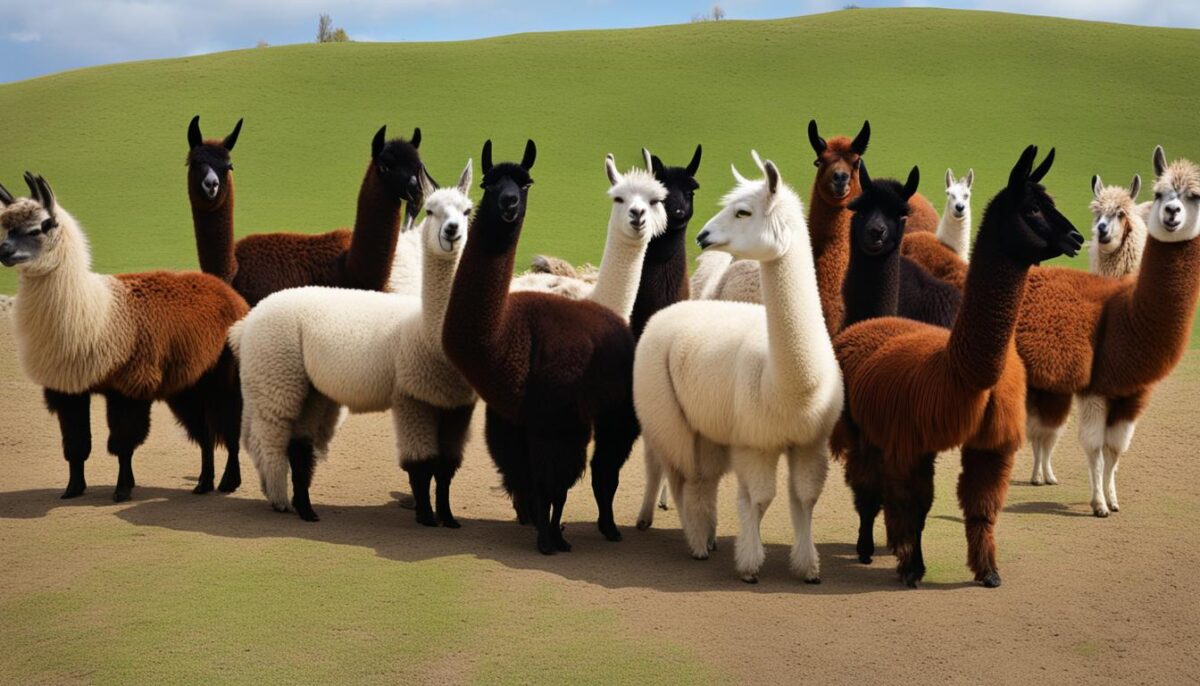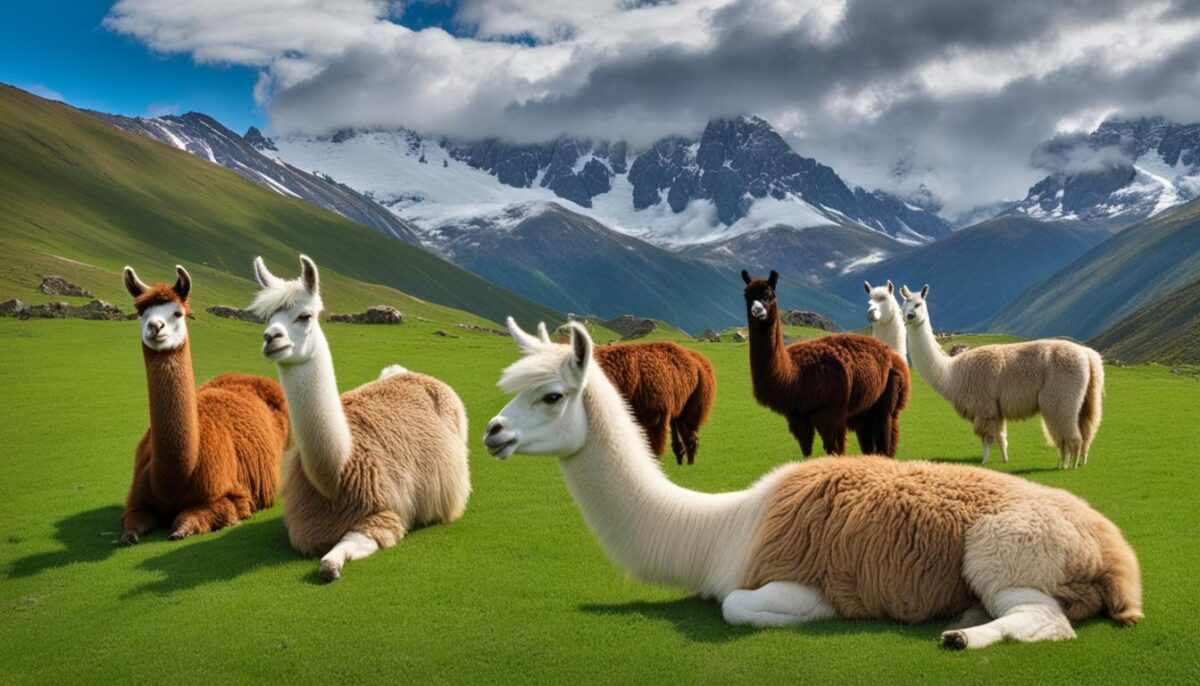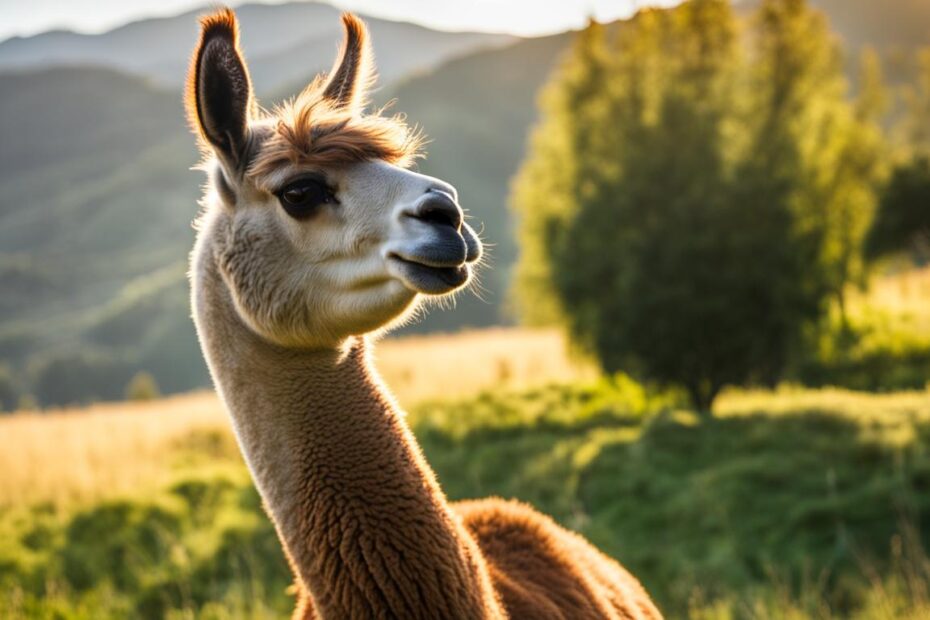Llamas are fascinating creatures with a unique vocal repertoire. Have you ever wondered what sounds a llama makes? In this article, we will delve into the various types of sounds produced by llamas and explore the reasons behind their vocalizations. Understanding llama vocalizations is not only interesting but also important for better communication and interaction with these incredible animals.
Key Takeaways:
- Llamas have a diverse vocal repertoire, ranging from low-pitched hums to alarm calls.
- Humming is a common sound that llamas make when they are content or relaxed.
- They also use snorts, clucks, and grunts to show aggression or signal danger.
- Llamas communicate not only with humans but also with other animals through their vocalizations.
- Understanding llama vocalizations can help interpret their behavior and establish a stronger connection with them.
The Vocal Repertoire of Llamas
Llamas are known for their unique vocalizations, which they use to communicate with each other and other animals. Understanding these vocal signals can provide valuable insights into their behavior and social dynamics. Let’s explore the different types of sounds llamas make and their meanings.
Types of Llama Vocalizations
Llamas have a diverse vocal repertoire that includes various sounds and pitches. The most common sound they make is a low-pitched hum, which can range from a soft, contented hum to a louder, more intense hum when they are anxious or alarmed. This humming noise serves as a way for llamas to maintain social connections within their herd and can convey different emotions and intentions.
In addition to humming, llamas also produce other vocalizations such as squeaks and whistles, especially during play and interaction with other llamas. These higher-pitched sounds are often associated with excitement and positive social engagement.
| Vocalization | Meaning |
|---|---|
| Hum | Contentment, connection |
| Intense hum | Anxiety, alarm |
| Squeak/whistle | Play, excitement |
“Llamas have a diverse vocal repertoire that includes various sounds and pitches.”
The Functionality of Llama Vocalizations
Llama vocalizations serve several important functions. Humming helps llamas stay connected with their herd members, reinforcing social bonds and promoting a sense of security. By adjusting the volume and pitch of their hums, llamas can indicate their emotional state and potential threats in the environment. This vocal communication plays a crucial role in their social organization and overall well-being.
Llamas also use different vocal signals to establish dominance or show aggression. Louder noises like snorts, grunts, and hisses can be used to maintain boundaries and communicate territoriality. These signals are particularly common during confrontations or encounters with unfamiliar llamas or other animals.
“Humming helps llamas stay connected with their herd members, reinforcing social bonds and promoting a sense of security.”
Overall, llama vocalizations are a vital part of their communication toolkit. By paying attention to their vocal cues and understanding their meanings, we can develop a better understanding of llamas’ social dynamics and enhance our interactions with these fascinating animals.
The Functionality of Llama Vocalizations
Llama vocalizations serve various functions and convey different messages. Understanding the different types of sounds llamas make can provide valuable insights into their behavior and communication patterns. Let’s explore the functionality of llama vocalizations and the meanings behind their sounds.
Social Communication
Llamas are social animals that live in herds, and vocalizations play a crucial role in maintaining social connections within the group. One of the most common sounds llamas make is a low-pitched hum. This humming serves as a way for llamas to stay connected with each other, expressing contentment and relaxation. The volume and pitch of their hums can increase when they are distressed or alarmed, signaling the need for attention or warning other herd members of potential danger.
Alarm Calls and Aggression
Aside from humming, llamas also use other vocal signals to convey different messages. Llamas have alarm calls such as snorts and clucks, which they use to alert the herd of potential threats. These sounds are louder and more intense, indicating a higher level of distress or danger. Furthermore, llamas may use these vocalizations to establish dominance within their hierarchical structure. Snorts, grunts, and hisses are often used during aggressive encounters to intimidate rivals or assert their position in the herd.
| Vocalization | Function |
|---|---|
| Humming | Expressing contentment and relaxation |
| Snorts and Clucks | Signaling alarm or potential danger |
| Snorts, Grunts, and Hisses | Establishing dominance or asserting position in the herd |
Communication with Humans
Llamas also use vocalizations to communicate with humans. When interacting with people, llamas may make different sounds to express their emotions or intentions. Snorting, humming, and clucking are examples of how llamas communicate their comfort or discomfort. By understanding these vocal signals, humans can better interpret llama behavior and respond accordingly, strengthening the bond between llamas and their human caregivers.

Llamas and Communication with Humans
Llamas, with their unique vocal repertoire, also use vocalizations to communicate with humans. When interacting with humans, llamas may produce a range of sounds to express their emotions or intentions. Understanding the different types of sounds llamas make can help humans interpret their behavior and build a stronger connection with these remarkable animals.
Llama Vocal Repertoire
Llamas use a variety of vocal signals when communicating with humans. Here are some of the common sounds they make:
- Snorts: Llamas may emit snorts to express their discomfort or displeasure. This vocalization is often accompanied by body language cues such as raised ears or a stiff posture.
- Humming: Llamas use humming as a way to convey their contentment or relaxation. It is a gentle, low-pitched sound that can indicate their overall mood.
- Clucking: Llamas may cluck to express curiosity or interest. This sound is often accompanied by slight head movements or a forward-leaning posture.
By paying attention to these vocalizations and observing the accompanying body language, humans can better understand the needs and emotions of llamas when interacting with them.
“Llamas, with their unique vocal repertoire, also use vocalizations to communicate with humans.”
Furthermore, it is important to note that llamas are highly perceptive animals and can pick up on human emotions and cues. They can recognize familiar people and respond differently based on their level of comfort and trust. Building a bond of trust and respect through positive interactions and clear communication can enhance the relationship between humans and llamas. Whether it is a gentle hum of contentment or a subtle snort of concern, llamas’ vocal repertoire offers valuable insights into their thoughts and feelings.
A Note on Respectful Communication
When communicating with llamas, it is essential to approach them with respect and understanding. Llamas are sensitive animals, and loud or aggressive behavior can cause them stress or fear. It is crucial to maintain a calm and gentle demeanor and give them space when needed. As with any form of communication, listening and observing are key to successful interactions with llamas.
Llama Communication with Other Animals
Aside from communicating with humans, llamas also have a unique way of interacting with other animals. When encountering species such as goats, sheep, pigs, cows, or horses, llamas exhibit distinct vocalizations that convey different messages depending on the situation. These sounds play a crucial role in establishing relationships and maintaining social dynamics.
When it comes to communicating with other animals, llamas often use low-pitched hums to indicate familiarity and acceptance. This gentle humming serves as a way to build connections and establish a sense of comfort. It is fascinating to witness the calming effect these sounds have on other animals, creating a peaceful environment for all.
However, llamas also utilize louder and more assertive vocalizations when necessary. In situations where they require space or feel threatened, llamas may emit snorts to assert their boundaries or signal the need for distance. These sounds act as a warning to other animals, effectively communicating their intentions and maintaining their safety.
Llama Communication with Different Species
One remarkable aspect of llama communication is their ability to recognize individual members of various herds and respond accordingly. Each encounter with a different animal species is met with a different vocal cue, highlighting the llamas’ social intelligence and adaptability.
Through sound cues, llamas can differentiate between friendly and potentially dangerous animals. They rely on their vocal repertoire to create a harmonious coexistence with other species. For example, when llamas come across animals they consider part of their herd or a non-threatening presence, they respond with gentle humming and relaxed body language. This behavior fosters a sense of unity and camaraderie.
By contrast, when confronted with unfamiliar or potentially aggressive animals, llamas may utilize a range of vocalizations to communicate their caution and self-defense. These vocal cues, such as snorts or hisses, are designed to ward off potential threats and ensure the safety of both the llamas and the animals around them.
| Species | Llama Vocalization | Message Conveyed |
|---|---|---|
| Goats | Low-pitched hum | Friendliness and acceptance |
| Sheep | Sudden snort | Warning to keep distance |
| Pigs | Aggressive grunt | Asserting dominance and boundaries |
| Cows | Long, deep hum | Familiarity and non-threatening presence |
| Horses | Snort with raised head | Caution and self-defense |
The Size and Appearance of Llamas
Llamas are fascinating creatures that exhibit unique physical characteristics. They are one of the smallest members of the South American camelid family, with an average height of 6 feet. These gentle giants can weigh up to 400 pounds, making them quite substantial in size.
Llamas have a distinctive appearance with their long necks, short tails, and padded split hooves. These hooves allow them to traverse rocky terrain with ease, making them well-adapted to their natural habitat. They come in various colors, ranging from white to various shades of brown and black.
Llamas have a majestic presence and exude elegance with their graceful movements and proud posture. Their woolly coat adds to their charm, making them a favorite among farmers, fiber enthusiasts, and animal lovers alike. Llamas are domesticated animals that have been bred for thousands of years for various reasons, including wool production, meat, and serving as beasts of burden.
The Physical Characteristics of Llamas
| Physical Attribute | Description |
|---|---|
| Height | On average, llamas stand at a height of 6 feet. |
| Weight | Llamas can weigh up to 400 pounds. |
| Hooves | Llamas have padded split hooves that aid in navigating rough terrain. |
| Coat | They have a woolly coat that varies in color from white to brown to black. |
“The size and appearance of llamas make them truly mesmerizing creatures, capturing the hearts of all who encounter them.”
The Natural Habitat of Llamas
Llamas are native to the Andes Mountains in South America, where they have thrived in their natural habitat for centuries. They can be found in various countries within the mountain ranges, including Peru, Bolivia, Chile, Argentina, Colombia, Ecuador, and Venezuela. These regions provide the ideal conditions for llamas to thrive, with elevations exceeding 15,000 feet.
Llamas have adapted to their mountainous habitat and are well-suited to the harsh conditions found at high altitudes. They have a thick, warm coat that helps protect them from the cold temperatures, strong winds, and intense sunlight. Llamas are also highly efficient at conserving water, which is crucial in their arid environment.
In their natural habitat, llamas primarily feed on grasses, leaves, twigs, and bark. They are herbivores and have evolved to consume a diet that is rich in fiber and low in protein. Llamas have a unique digestive system that allows them to extract maximum nutrition from the vegetation available in their habitat.

The Predators of Llamas
While llamas are known for their gentle nature, they do have natural predators in their habitat. Pumas, also known as mountain lions, are one of the main threats to llamas. These large cats are skilled hunters and can easily take down a llama if given the opportunity. Foxes are another predator that may prey on young or weaker llamas.
Llamas have developed several defense mechanisms to protect themselves from predators. They have exceptional eyesight and hearing, which allows them to detect potential threats from a distance. Llamas will often use their vocalizations, such as alarm calls, to alert others in the herd of impending danger. In addition, llamas have strong legs and can deliver powerful kicks to fend off attackers.
Overall, llamas have adapted to their natural habitat and developed strategies to survive in the presence of predators. Their strong herding instincts and complex social structure also contribute to their ability to protect themselves and ensure the safety of the group.
Lifecycle of Llamas
Llamas go through a fascinating lifecycle that consists of various stages, including birth, growth, and adulthood. Understanding the different phases of a llama’s life can provide valuable insights into their behavior and care.
Birth and Early Life
Female llamas, known as dams, give birth to a single cria after a gestation period of around 11 months. Crias weigh between 9 and 14 kilograms at birth and are typically able to stand and nurse within the first hour. During the early stages of their life, crias depend on their dam for nourishment and protection.
As the cria grows, it starts exploring its surroundings and interacting with other members of the herd. This phase is crucial for social development and learning from older llamas. Young llamas, known as cria or juveniles, gradually gain independence and develop their own unique personalities.
Adulthood and Maturity
Llamas reach maturity at around 2 to 3 years of age, both in terms of their physical size and reproductive capabilities. Fully grown llamas have an average height of 6 feet and can weigh up to 400 pounds. They become active members of the herd and establish social bonds with other llamas.
Mature llamas have distinctive roles within the hierarchy of their herd, with dominant individuals guiding and protecting the group. They display various behaviors, vocalizations, and body postures to establish their dominance and maintain social order. During this stage, llamas also exhibit mating behaviors and can reproduce to contribute to the next generation of llamas.
| Llama Lifecycle | Duration |
|---|---|
| Gestation Period | Around 11 months |
| Birth Weight | 9 to 14 kilograms |
| Maturation Age | 2 to 3 years |
| Average Lifespan | 15 to 25 years |
Llamas have an average lifespan of 15 to 25 years, with some individuals living even longer. Throughout their lifecycle, llamas contribute to the rich social dynamics of their herd and play an essential role in their ecosystem.
By understanding the lifecycle of llamas, caretakers and enthusiasts can provide appropriate care, support their reproductive needs, and ensure the well-being of these remarkable animals.
Llamas and their Unique Wool
Llamas are not only known for their vocalizations but also for their unique wool, which is highly valued for its quality and versatility. Llama wool, also known as fiber, is treasured for its softness, warmth, and hypoallergenic properties. Unlike sheep’s wool, llama wool contains minimal lanolin, making it suitable for individuals with wool allergies. The fibers are finer and smoother, resulting in a luxurious and comfortable material for various products.
The quality and color of llama wool vary based on several factors, including genetics, breeding, and individual llama characteristics. Llama wool comes in a wide range of natural colors, including shades of white, tan, brown, and black. Each color has its unique beauty and can be used to create visually stunning textiles and garments. The versatility of llama wool allows it to be spun, woven, and knitted into a variety of products, including clothing, blankets, carpets, and accessories.
Llama wool is highly regarded for its insulation properties, keeping individuals warm during cold weather and cool during hot temperatures. Its lightweight nature makes it comfortable to wear, and it has excellent moisture-wicking capabilities, helping to regulate body temperature and keep the skin dry. Additionally, llama wool is known for its durability and resistance to wrinkling, making it a practical choice for long-lasting, low-maintenance garments.
| Benefits of Llama Wool | Characteristics |
|---|---|
| Softness | Sumptuously soft and gentle against the skin. |
| Hypoallergenic | Minimal lanolin content, suitable for individuals with wool allergies. |
| Variety of Colors | Natural hues ranging from white to black, offering a wide selection for design. |
| Insulation | Keeps individuals warm in cold weather and cool in warm temperatures. |
| Moisture-Wicking | Regulates body temperature and keeps the skin dry. |
| Durability | Long-lasting and resistant to wrinkling. |

Llamas in Modern Culture
Today, llamas continue to captivate people’s imaginations and are popular animals in zoos, farms, and as companions in some regions. Their unique appearance and gentle nature make them fascinating creatures to observe and interact with. Llamas have become a symbol of resilience, adaptability, and the vibrant cultural heritage of the Andean people.
The cultural significance of llamas extends beyond the Andean region. In contemporary society, llamas have become cultural icons, often associated with a sense of whimsy and humor. From llama-themed merchandise to viral internet memes featuring llamas, these animals have captured the attention and affection of people worldwide.
Summary
With their rich mythological and cultural significance, llamas have woven themselves into the fabric of human history. From their revered status in ancient mythology to their practical role in Andean cultures, llamas continue to symbolize strength, resilience, and the deep connection between humans and the natural world. These remarkable creatures embody the beauty and diversity of our planet’s animal kingdom.
Conclusion
Summarizing Llamas Vocalizations
Llamas are fascinating creatures with a diverse vocal repertoire. Through their various sounds, they communicate with each other, humans, and other animals. From low-pitched hums to alarm calls like snorts and clucks, llamas use vocalizations to express their emotions, intentions, and warnings. Understanding their vocalizations is crucial not only for interpreting their behavior but also for establishing a stronger connection with them.
By studying llama vocalizations, we can gain insight into their behavior and social dynamics. The different types of vocal signals llamas use, such as humming, squeaks, and whistles, provide valuable information about their contentment, distress, and desire for interaction. These vocal patterns help llamas maintain social connections within their herd and establish dominance in their hierarchy.
Furthermore, llama vocalizations extend beyond their interactions with other llamas. Llamas use different sounds to communicate with humans, expressing their comfort or discomfort. They also have distinct vocalizations when encountering other animals, conveying messages of familiarity, acceptance, or the need for space. By understanding their vocal repertoire, we can better interpret llama behavior and ensure their well-being through effective communication.
FAQ
What sounds does a llama make?
Llamas make a range of sounds, including low-pitched hums, squeaks, whistles, snorts, clucks, grunts, and hisses.
Why do llamas make humming noises?
Llamas use humming to communicate contentment or alarm. The volume and pitch of their humming can increase when they are distressed or alarmed.
What do llamas use snorts and clucks for?
Llamas use snorts and clucks as alarm calls to alert others of potential threats.
How do llamas communicate with humans?
Llamas can use snorts, humming, and clucking to convey their comfort or discomfort when interacting with humans.
How do llamas communicate with other animals?
Llamas produce different sounds to communicate with other animals. They may use low-pitched hums to indicate familiarity and acceptance or louder snorts to signal the need for space.
How big are llamas?
Llamas have an average height of 6 feet and can weigh up to 400 pounds.
Where do llamas live?
Llamas are originally from the Andes Mountains in South America and can be found in countries like Peru, Bolivia, Chile, Argentina, Colombia, Ecuador, and Venezuela.
How long do llamas live?
Llamas typically live for 15 to 25 years, with some individuals surviving even longer.
What is llama wool used for?
Llama wool is used to produce clothing, textiles, and other fiber-based goods due to its quality and hypoallergenic properties.
What is the cultural significance of llamas?
Llamas hold cultural and mythological significance in various societies, particularly in Andean cultures where they have been domesticated and used for transportation and trade for thousands of years.


